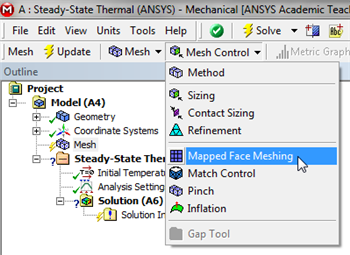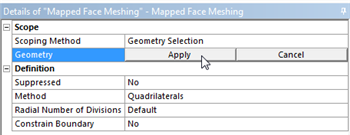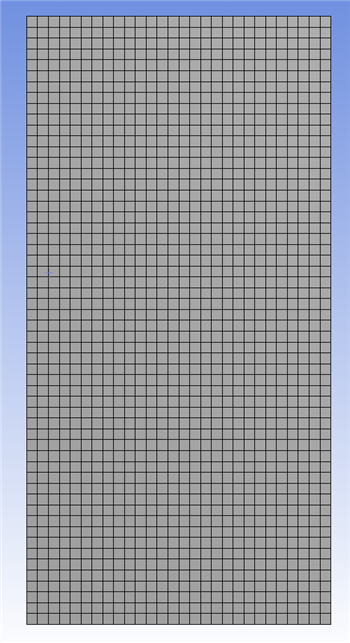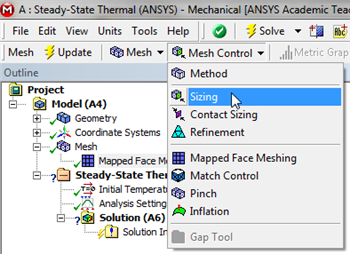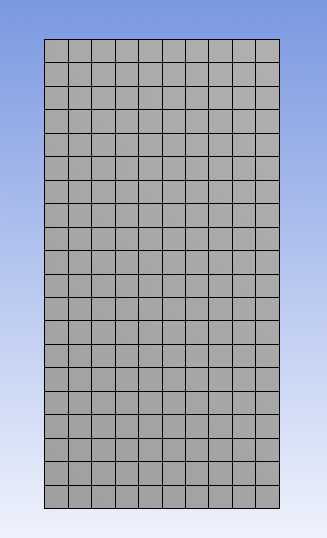...
| Panel |
|---|
Author: John Singleton, Cornell University Problem Specification |
3. Mesh
For the mesh we In the step, we'll discretize or chop up the domain to create a mesh containing many "elements". During the numerical solution, ANSYS will obtain a discrete version of our boundary value problem on this mesh. We will generate a mapped regular face mesh with 200 elements. The horizontal edges will have 10 divisions and the vertical edges will have 20 divisions.
Launch ANSYS Mechanical
ANSYS Mechanical is the application where we'll generate a mesh, apply the material properties and boundary conditions, and obtain a numerical solution to our boundary value problem. In order to start ANSYS Mechanical (Double Click) Model, .
Mapped Face Meshing
Create a Regular Mesh
We will create a nice, regular mesh which is done using the "For this simulation we will use a mapped face mesh" option. A mapped face mesh is a mesh that can be mapped to a rectangular domain, hence the name. The Our domain for this simulation is already rectangular, thus mapped faced meshing will yield a rectangular grid as the mesh.
First In order to implement the mapped face meshing, first (Click) Mesh, in the model tree. Next, (Click) Mesh Control > Mapped Face Meshing, as shown below.
| newwindow | ||||
|---|---|---|---|---|
| ||||
https://confluence.cornell.edu/download/attachments/146918513/MFM_Full.png |
Then, click on the rectangle and it should highlight green. If it does not highlight green, click on the face selection filter button, at the top of the GUI,then click on the rectangle. Once the rectangle has been selected, (Click) Apply in the "Details of Mapped Face Meshing" table as shown below.
| newwindow | ||||
|---|---|---|---|---|
| ||||
https://confluence.cornell.edu/download/attachments/146918513/DMFM_Full.png |
ANSYS now knows that a mapped face mesh has to be generated for the rectangle. Next, (Click) Update, , in order to generate the mesh. You should obtain the following mesh.
| newwindow | ||||
|---|---|---|---|---|
| ||||
https://confluence.cornell.edu/download/attachments/146918513/GenMesh_Full.png |
Edge Sizing
At this point Let's specify the number of divisions along the sides of the rectangle will be specifiedto be used along each edge rather than have ANSYS pick them automatically. ANSYS calls this step "edge sizing". We will us use 20 divisions along the vertical sides edges and 10 divisions along the horizontal sidesedges. We will work with the horizontal side edge first. In order to implement the edge sizing, first (Click) Mesh, . Next, (Click) Mesh Control > Sizing, as shown below.
| newwindow | ||||
|---|---|---|---|---|
| ||||
https://confluence.cornell.edu/download/attachments/146918513/InsSizing_Full.png |
Next, click on the edge selection filter, . Then click on the bottom edge of the rectangle and (Click) Apply in the "Details of Sizing" table as shown below.
| newwindow | ||||
|---|---|---|---|---|
| ||||
https://confluence.cornell.edu/download/attachments/146918513/DetSizing_Full.png |
Next, set Type to Number of Divisions and set Number of Divisions to 10, as shown below.
| newwindow | ||||
|---|---|---|---|---|
| ||||
https://confluence.cornell.edu/download/attachments/146918513/detdet_full.png |
This completes the sizing for the horizontal edge. Now, create a new edge sizing, apply it to the right vertical edge and set the Number of Divisions to 20. After, you have properly implemented the two edge sizing commands, (Click) Update, , in order to generate the new mesh. You should then obtain the following mesh.
...
Save the project now. Do not close Mechanical yet.
Go to Step 4: Setup (Physics)
See and rate the complete Learning Module
Go to all ANSYS Learning Modules
 Sign-up for free online course on ANSYS simulations!
Sign-up for free online course on ANSYS simulations!

